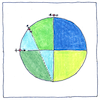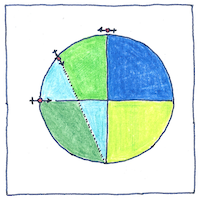William Gilbert
electromagnetism

|
Magnetism
The Chinese were the first to create compasses made of lodestones and to use them for navigation. Western civilizations had only fantastical notions of why compasses worked until William Gilbert did some experiments and declared that the earth was a big magnet. Like any magnet, other magnets align with it, north and south. Moreover, he concluded, the earth at its core must be made of iron.
Experimental method
William Gilbert found that lodestone is a form of iron and that iron itself can be made to act like a lodestone. He floated an iron wire by wrapping it around a cork and found that another piece of iron at a distance would move it. A bar of iron loses its magnetism when it is red hot and regains its power to attract as it cools. Because a rubbed amber does not disturb a candle flame, he realized electric attraction is not a disturbance of the air. Because heat and water affect electrical and magnetic objects differently he thought that they were distinct effects. He cut a magnet in half and noted that each half had its own north and south poles. He made himself a model of the earth, a spherical magnet that he named a terrella. The terrella mimicked the magnetic properties of the earth, its power to orient a compass to its north and to dip a compass below the horizon according to its latitude. Thus William Gilbert was one of the first physicists to establish the value of experiment over scholastic teaching.
Action at a distance
William Gilbert wrote, “For since no action can take place by means of matter unless by contact, these electricks are not seen to touch, but, as was necessary, something is sent from the one to the other, something which may touch closely and be the beginning of that incitement.” James Clerk Maxwell explained that electromagnetism is not action at a distance. Einstein explained that gravity is not action at a distance. Electromagnetism is only the influence of a localized field, and gravity is only a curvature of space and time. Magnetism is a field resulting from an electric current or the alignment of magnetic moments of many atomic nuclei. But what is an electromagnetic field? How does mass or energy bend space and time? Most of us have a murky understanding of why a magnet can form a pattern in iron filings. But we take it for a fact because we played with magnets when we were children, or we can test them now.



William Gilbert was a physician, serving as the president of the Royal College of Physicians and as the personal physician of Elizabeth I and, later, James I.
Gilbert invented the first electrical measuring instrument, the electroscope. Our word electricity derives from his use of the Greek word for amber, elektron, to stand for its attractive property.
Today, particle physicists model an electromagnetic field as an exchange of virtual photons. It is one of the four fundamental physical interactions—electromagnetic, gravitational, strong nuclear, and weak nuclear.
See also in The book of science:
Readings in wikipedia:
Other readings: